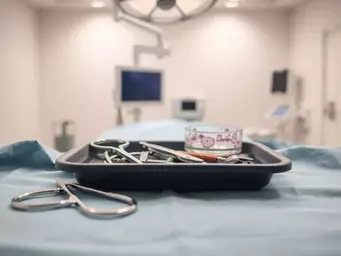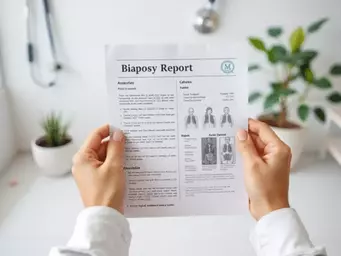Have you ever faced a medical diagnosis and wondered how accurate the results truly are? Understanding the complexities behind biopsy interpretations can significantly impact your health decisions. In this article, we unravel the intricacies of false negative biopsy results and why staying informed is crucial for your health journey.
What You Will Learn
- A false negative biopsy result can lead to a false sense of security, potentially delaying necessary treatment.
- Understanding the differences between false negatives and false positives can empower patients to seek appropriate medical guidance.
- Common causes of false negatives include sampling errors, lesion heterogeneity, and interpretation mistakes by pathologists.
- Effective communication with healthcare providers is essential; don’t hesitate to ask questions or seek second opinions regarding your results.
False Negative Biopsy Results: Key Comparisons and Causes
This visual highlights the critical differences between false negatives and false positives in biopsy results, along with common contributing factors to false negatives.
False Negative vs. False Positive
False Negative: Disease is present, but test says it isn't.
False Positive: No disease present, but test says it is.
Crucial for patient understanding and treatment planning.
Common Causes of False Negatives
- • Sampling Errors: Insufficient tissue.
- • Lesion Heterogeneity: Varied tissue interpretation.
- • Technical Factors: Biopsy procedure limitations.
- • Interpretation Errors: Pathologist misdiagnosis.
Understanding these factors empowers patients.
Understanding False Negative Biopsy Results: Key Definitions
When we talk about false negative biopsy results, it's essential to recognize what this means for patients. A false negative occurs when a biopsy indicates that there is no disease or abnormality present, even when there actually is one. This can lead to a false sense of security for patients, as they may believe their health is fine when, in fact, further evaluation is needed.
Understanding this term is crucial because it underscores the importance of thorough follow-up and communication with healthcare providers. As a board-certified pathologist, I've seen firsthand how these results can affect patient care decisions, and it's vital to remain engaged in your health journey!
What Are False Negative Biopsy Results?
To put it simply, a false negative biopsy result means that the tissue sample taken during the biopsy did not show any signs of disease, but the patient does indeed have a condition. This can happen due to several factors, which we'll explore later on. It's a critical aspect of medical diagnostics that can impact treatment plans and patient outcomes.
- A false negative can lead to delayed treatment, which might worsen the patient's condition.
- Patients may experience unnecessary anxiety when they believe their health is in the clear.
- Understanding this concept helps empower patients to advocate for their health more effectively.
At What Is A Biopsy, I strive to provide clear and accessible information about these complex issues. Being informed allows you to have meaningful conversations with your healthcare team!
False Negatives vs. False Positives: Clarifying the Differences
It's helpful to differentiate between false negatives and false positives. A false positive occurs when a biopsy indicates the presence of disease when there is none. While both scenarios can lead to complications, they manifest differently. Here’s a quick comparison:
- False Negative: Disease is present, but the test result says it isn’t.
- False Positive: No disease present, but the test result indicates there is.
Understanding these differences can help patients better navigate their healthcare options. If you find yourself in a situation where your biopsy results are confusing, don't hesitate to reach out to your medical provider for clarification!

Common Causes of False Negative Biopsy Results
Several factors can lead to false negative biopsy results, and it's important to be aware of them. Understanding these causes can help you discuss any concerns with your healthcare provider effectively.
- Sampling Errors: Issues that arise during the collection of tissue samples. For example, some studies highlight how the accuracy of biopsy results can be affected by the sampling process itself, particularly in cases where the lesion's characteristics vary. You can learn more about how factors like these impact diagnostic accuracy by reviewing research on biopsy performance benchmarks.
- Lesion Heterogeneity: Variability in the tissue that may cause misinterpretation. The diverse nature of some lesions can make it challenging to capture diseased tissue, leading to a false negative. This can be particularly relevant in breast lesions, as discussed in a systematic review on MRI-guided breast biopsies.
- The Role of Necrotic Tissue: How dying tissue can affect results.
- Technical Factors: Limitations inherent to biopsy procedures. For instance, the type of biopsy performed can influence its sensitivity. Clinical trials, like those registered on ClinicalTrials.gov, often investigate the efficacy of different diagnostic techniques.
- Interpretation Errors: Misdiagnosis due to evaluation mistakes.
- Understanding Diagnostic Accuracy: The significance of sensitivity and specificity in tests.
By becoming familiar with these potential causes of false negatives, you can better understand the diagnostic process and play an active role in your healthcare decisions. Remember, knowledge is power!
We Want to Hear From You!
Have you ever received biopsy results that raised questions or concerns for you? Share your experience or thoughts below:
Frequently Asked Questions About False Negative Biopsy Results
- What is a false negative biopsy result?
- A false negative biopsy result occurs when a biopsy indicates no disease or abnormality is present, even though a condition actually exists. This means the test missed the disease.
- How does a false negative differ from a false positive?
- A false negative means the disease is present, but the test result says it isn't. A false positive means there is no disease present, but the test result indicates there is.
- What are the common causes of false negative biopsy results?
- Common causes include sampling errors (insufficient tissue collected), lesion heterogeneity (variability in tissue interpretation), technical factors (limitations of biopsy procedures), and interpretation errors by pathologists.
- Why is understanding false negatives important for patients?
- Understanding false negatives is crucial because it can prevent a false sense of security, avoid delayed treatment, and empower patients to ask informed questions and seek second opinions, ultimately advocating for their health.
- What steps can patients take if they suspect a false negative?
- Patients should communicate effectively with their healthcare provider, ask clarifying questions, consider getting a second opinion, research their condition, and build a support network.
Summarizing the Importance of Understanding False Negative Biopsy Results
Understanding false negative biopsy results is crucial for patients and healthcare providers alike. By recognizing the potential causes and risks, we can better navigate the complexities of diagnostic processes. Let's explore some key takeaways that can empower you to take control of your health journey.
Key Takeaways on Causes and Risks
- Sampling errors can lead to missed diagnosis due to insufficient tissue collection.
- Lesion heterogeneity means that different areas within a tumor may behave differently, complicating results.
- Technical factors, such as the type of biopsy performed, can impact the accuracy of results.
- Interpretation errors by pathologists can occur, leading to potential misdiagnosis.
Remember, understanding these factors can help you engage in meaningful discussions with your healthcare team at What Is A Biopsy about your results and next steps. Being informed is a powerful way to advocate for your health!
Empowering Patients: Steps to Take When Facing Potential Errors
If you're feeling uncertain about your biopsy results, you're not alone. Here are some actionable steps you can take:
- Research your condition: Understanding the specifics can help you discuss your concerns with confidence.
- Ask questions: Don’t hesitate to reach out to your healthcare provider for clarification on your results and the reasoning behind them.
- Consider a second opinion: It’s perfectly reasonable to seek further insights from another medical professional.
These steps not only enhance your understanding of your health but also empower you to engage more actively in your care decisions.

Taking Action: Your Next Steps If You Suspect a False Negative
If you suspect that your biopsy results may be inaccurate, it’s essential to take proactive steps to address your concerns. Here’s how you can start:
Communicating with Your Healthcare Provider: Essential Questions to Ask
Effective communication is key in healthcare. Here are some questions you might consider asking:
- What were the results of my biopsy, and what do they mean?
- What factors could have contributed to a false negative result?
- Are there additional tests that should be conducted?
- What are my options for follow-up?
These questions can help clarify your situation and ensure you receive the attention you need.
Building a Support Network: Resources for Emotional and Psychological Support
Facing a potential misdiagnosis can be stressful. Consider reaching out for support through:
- Support groups: Connecting with others who have similar experiences can provide comfort.
- Friends and family: Sharing your feelings with loved ones can help alleviate anxiety.
- Professional counseling: A therapist can help you navigate your emotions and provide coping strategies.
Remember, it’s okay to seek help! Surrounding yourself with support can enhance your mental wellbeing during challenging times.
Understanding Patient Rights and Advocacy in Diagnostic Processes
As a patient, you have rights that ensure you receive quality care. Here are some important points to remember:
- You have the right to access your medical records and understand your diagnosis.
- You can seek a second opinion without feeling guilty or uncomfortable.
- Being involved in your healthcare decisions is your prerogative—advocating for yourself is vital!
At What Is A Biopsy, we encourage you to be proactive in your health journey. Understanding your rights and advocating for yourself can lead to better outcomes and peace of mind.
Recap of Key Points
Here is a quick recap of the important points discussed in the article:
- False Negative Biopsy Results: Occur when a biopsy indicates no disease is present, despite the presence of a condition.
- Delayed Treatment: False negatives can lead to delayed treatment, worsening the patient's condition.
- Common Causes: Sampling errors, lesion heterogeneity, technical factors, and interpretation errors can all contribute to false negatives.
- Patient Empowerment: Research your condition, ask questions, and consider a second opinion if results are unclear.
- Effective Communication: It's essential to communicate openly with healthcare providers about biopsy results and possible follow-ups.
- Patient Rights: Patients have the right to understand their diagnosis and seek second opinions as needed.









